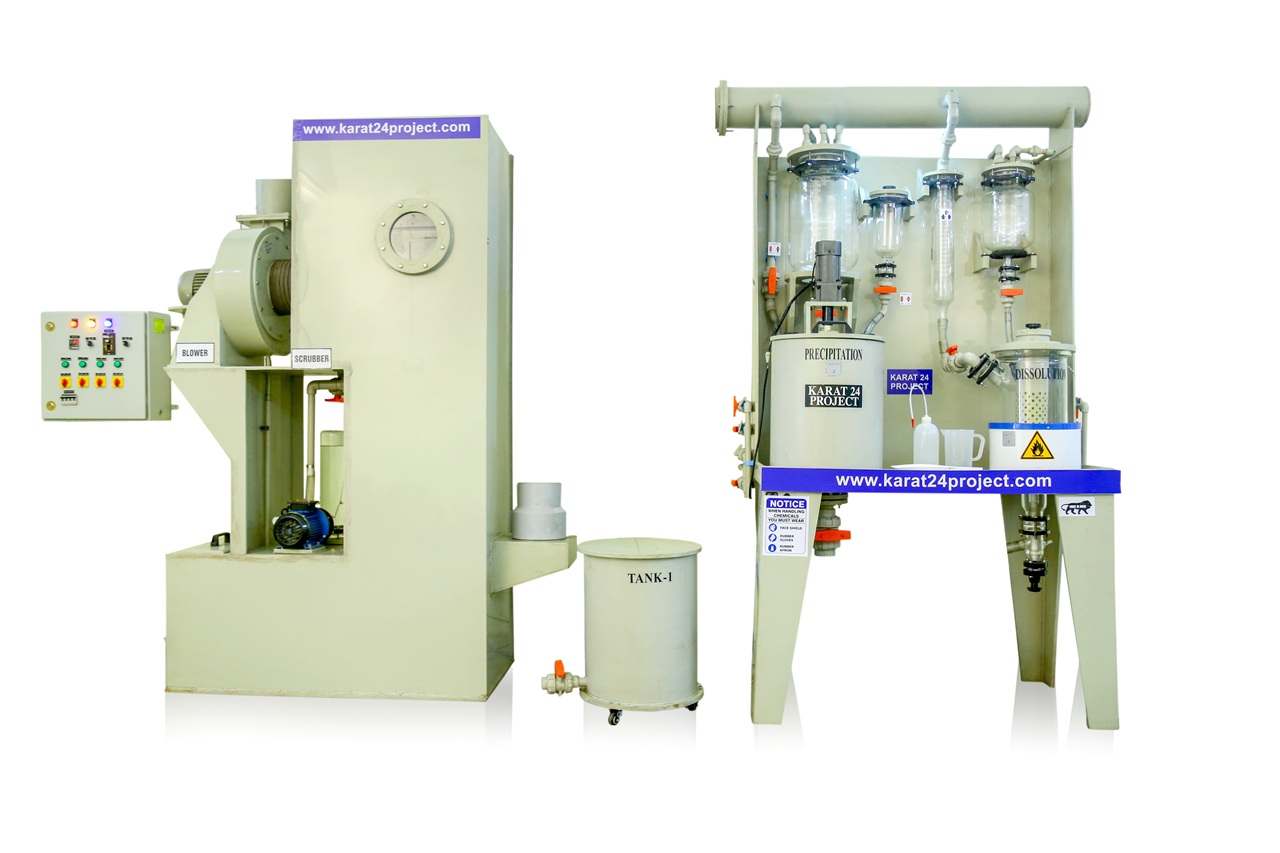Gold Refining Plant
The gold refining plant is engineered for the precise and efficient purification of gold alloys. It accommodates batch sizes ranging from 300 grams to 10 kilograms, with flexibility for larger industrial needs, scaling up to 100 kilograms per batch.
The plant is designed to produce high-purity gold, achieving a remarkable 99.99% purity level in a single cycle, typically completed within 5 to 8 hours.
The refining process leverages Aqua Regia, a well-balanced mixture of hydrochloric acid and nitric acid, to dissolve the raw gold alloy and separate impurities.
Key Specifications:
- Batch Processing Capacity: 300 grams to 10 kilograms, with the ability to scale up to 100 kilograms for large-scale industrial production.
- Cycle Time: Each refining cycle takes between 5 to 8 hours, allowing for multiple batches within a 24-hour operation.
- Gold Purity: Achieves purities between 99.95% and 99.99%, ensuring top-quality refined gold after each cycle.
- Power Compatibility: Designed for both three-phase and single-phase electrical systems, ensuring wide compatibility across different industrial setups.
- Space Requirements: A minimum workspace of 10 feet by 10 feet is needed for the plant, with scalability options based on plant size and operational needs.
Key Advantages:
- Compact and Space-Efficient: The plant’s design maximizes workspace efficiency, allowing for seamless integration into both small and large-scale operations.
- User-Friendly Interface: Simplified control systems make the operation accessible to both experienced professionals and new users.
- Cost-Effective Operation: Designed to optimize resource consumption, reducing overall operational costs without compromising quality.
- Environmental Safety: Equipped with an advanced fume control system that minimizes hazardous emissions, ensuring a safe and compliant working environment.
- High Gold Recovery Rate: The plant’s precision engineering significantly reduces gold loss during the refining process.
- Automated Acid Handling: Automated systems for acid loading and transfer increase safety while enhancing operational efficiency.
- Low Maintenance Needs: Constructed with durable materials to minimize downtime and reduce maintenance requirements, leading to greater long-term reliability.
Aqua Regia Refining Process:
The gold refining plant utilizes the Aqua Regia process, ideal for refining gold alloys with an initial purity of 600/1000 or higher. Alloys with lower initial purity may require extended processing times to reach desired purity levels.
- Silver Content Considerations: The plant operates most efficiently with gold alloys containing less than 10-12% silver. Higher silver content can slow the refining process, extending cycle time.
Material Preparation:
- Gold Alloy Processing: Alloys are melted and granulated into small grains or thin strips to increase surface area for faster and more efficient dissolution in the Aqua Regia mixture.
- Strips vs. Grains: Thin strips dissolve more rapidly than granules, allowing for reduced residue and increased refining efficiency.
Technical Features and Functionality:
- Acid-Resistant Hood: A polypropylene enclosure surrounds the entire processing area to prevent acid exposure, featuring an integrated fume recovery system to capture and neutralize hazardous vapors.
- Precise Digital Temperature Control: An electric heating system with digital controls ensures optimal reaction conditions, maintaining accurate temperatures during the refining process.
- Efficient Fume Condensation: A triple-coil condenser captures and neutralizes acid fumes, preventing environmental contamination.
- Safe Solution Transfer: A high-quality Italian-made compressed air diaphragm pump ensures secure and efficient transfer of acid solutions, minimizing exposure to harmful substances.
- Gold Precipitation Tank: A dedicated tank designed for controlled gold precipitation ensures that the process remains precise and predictable.
- Acid Storage and Transfer System: Separate, clearly labeled tanks for hydrochloric and nitric acids come equipped with diaphragm pumps for automated, safe transfer of these chemicals.
- Storage Trays: Non-corrosive polypropylene trays are used for safely handling and storing chemicals and equipment during and after the refining process.
- Electric Control Panel:
- Safety Features: Individual miniature circuit breakers for each motor enhance safety during operation.
- Dual Stirring Motors: Two independent motors for stirring, allowing for precise control of mixing speeds.
- Process Optimization: Integrated monitoring systems for temperature and RPM ensure that the process runs at optimal conditions for maximum yield.
- Emergency Stop: A prominently located emergency stop button provides quick shutdown if needed.
- Flexible Power Supply Configurations: The control panel supports adaptable power supply configurations to suit various operational requirements.
Frequently Asked Questions (FAQ)
1. What types of gold alloys can be processed in this plant?
The plant is designed to process gold alloys with an initial purity of 600/1000 or higher. Alloys with lower purity levels may require longer processing times, but they can still be refined efficiently.
2. What is the minimum and maximum batch size that the plant can handle?
The plant can handle batches as small as 300 grams and as large as 10 kilograms per batch. For large-scale industrial operations, the plant can be scaled up to handle up to 100 kilograms per batch.
3. How long does it take to refine a batch of gold?
Each refining cycle takes between 5 to 8 hours, depending on the initial purity of the gold and the size of the batch. The plant is capable of processing multiple batches within a 24-hour period.
4. What is the achievable purity of gold after refining?
The refining process achieves a purity of 99.95% to 99.99% gold, depending on the initial quality of the gold alloy and the specific process parameters.
5. What type of power supply is required for the plant?
The plant is compatible with both three-phase and single-phase power systems, providing flexibility for various industrial environments.
6. How much space is needed to operate the plant?
A minimum working area of 10 feet by 10 feet is required. The plant’s footprint can be adjusted for larger-scale operations, depending on the number of units and the specific setup.
7. Is the plant safe to operate?
Yes, the plant is equipped with advanced safety features, including an acid-resistant hood, a fume control system, automated acid handling, and safety shut-off mechanisms. It also includes individual circuit breakers for each motor and an emergency stop button for quick response.
8. Can the plant handle hazardous fumes?
Yes, the plant is equipped with a fume recovery system and a three-coil condenser to efficiently capture and neutralize acid fumes, ensuring a safe working environment.
9. How does the plant optimize gold recovery and minimize losses?
The plant’s precision engineering, combined with the Aqua Regia process, ensures minimal gold loss during refining. The design of the system, including automated stirring and precise temperature control, further enhances gold recovery rates.
10. Is the plant easy to maintain?
The plant is designed with low-maintenance materials, reducing downtime and ensuring long-term reliability. The automated acid handling and durable construction further contribute to minimizing maintenance needs.
11. Can the refining process handle alloys with high silver content?
The plant can process gold alloys with up to 10-12% silver content. However, higher silver concentrations may slow down the refining process and require longer cycle times. For optimal results, it is recommended to use alloys with lower silver content.
12. Is the plant suitable for small-scale or large-scale operations?
The plant is versatile and can be adapted for both small-scale and large-scale operations. It offers a flexible batch size range and can be scaled up to handle larger industrial production volumes, making it suitable for a variety of business needs.
13. How does the Aqua Regia process work in this plant?
The Aqua Regia method involves using a mixture of hydrochloric and nitric acids to dissolve the gold alloy, separating the gold from other metals and impurities. The process is precise, and the plant is optimized for quick dissolution, leading to high-purity gold output.




